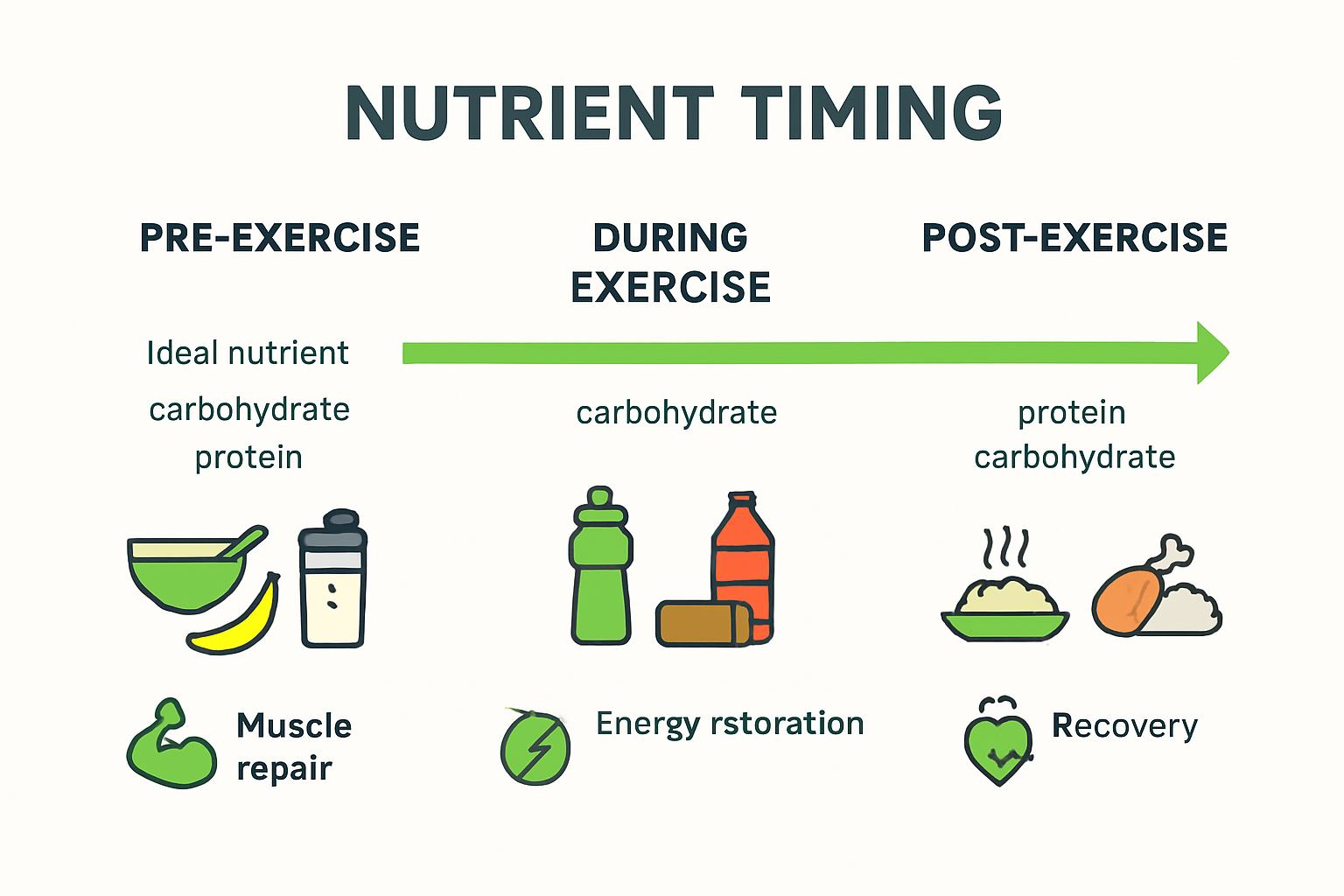Most people focus on what they eat, not when they eat it. The idea of timing your meals might sound trivial at first, but top athletes swear by it for a reason. Studies show that targeting your nutrient intake can boost muscle protein synthesis and recovery far more effectively than random eating. So it turns out that when you eat is just as important as what you eat, and missing these windows could hold you back more than you think.

Table of Contents
- Defining Nutrient Timing: What It Is And Its Purpose
- The Science Behind Nutrient Timing: Why It Matters
- Key Concepts Of Nutrient Timing: Macronutrients And Timing Phases
- Practical Applications Of Nutrient Timing In Fitness And Bodybuilding
- Nutrient Timing In Real Life: Success Stories And Common Misconceptions
Quick Summary
| Takeaway | Explanation |
|---|---|
| Time nutrients strategically around workouts | Optimise nutrient intake at pre, during, and post-exercise phases to enhance performance and recovery. |
| Understand metabolic windows for nutrient absorption | Identify critical periods when your body effectively utilises nutrients to support muscle growth and recovery. |
| Personalise your nutrient timing strategy | Tailor nutrient intake based on individual needs, training intensity, and fitness goals for maximum effectiveness. |
| Prioritise protein and carbohydrates post-workout | Consuming fast-absorbing proteins and carbs within 30 minutes post-exercise helps initiate muscle repair and replenish energy. |
| Challenge common nutrient timing myths | Recognise that rigid meal schedules and one-size-fits-all strategies may not yield optimal results for everyone. |
Defining Nutrient Timing: What It Is and Its Purpose
Nutrient timing represents a strategic nutritional approach that focuses on consuming specific nutrients at precisely calculated moments around exercise sessions to maximise performance, recovery, and physiological adaptations. This sophisticated nutritional methodology goes beyond simple calorie counting, targeting the optimal windows of opportunity when your body can most effectively utilise nutrients.
The Core Principles of Nutrient Timing
At its fundamental level, nutrient timing revolves around understanding how different nutrients interact with your body’s metabolic processes during and after physical activity. Research from the Journal of the International Society of Sports Nutrition demonstrates that strategic nutrient intake can significantly influence muscle protein synthesis, glycogen replenishment, and overall exercise performance.
The key principles of nutrient timing include:
- Pre Exercise Nutrition: Preparing the body with appropriate nutrient intake before physical activity
- Intra Exercise Nutrition: Maintaining energy and performance during exercise
- Post Exercise Nutrition: Supporting recovery and muscle repair after physical exertion
Understanding Metabolic Windows
Metabolic windows represent critical periods when your body becomes exceptionally responsive to nutrient absorption. During these timeframes, muscle cells become more permeable and can efficiently uptake proteins, carbohydrates, and other essential nutrients. This enhanced absorption potential allows athletes and fitness enthusiasts to optimise their nutritional strategies, potentially improving muscle growth, reducing recovery time, and enhancing overall performance.
By comprehending these metabolic windows, individuals can precisely calibrate their nutrient intake to match their body’s physiological requirements, transforming nutrition from a passive process into an active performance enhancement strategy.
The goal is not just consuming nutrients, but consuming them at the most opportune moments to trigger specific physiological responses that support fitness and health objectives.
The Science Behind Nutrient Timing: Why It Matters
Nutrient timing represents a sophisticated scientific approach that transcends traditional nutritional strategies by understanding the intricate biochemical processes governing metabolism, muscle synthesis, and energy utilisation. The scientific foundation of nutrient timing reveals how precise nutrient intake can dramatically influence physiological responses and performance outcomes.
Metabolic Signalling and Hormonal Responses
Research published in the Journal of the International Society of Sports Nutrition demonstrates that nutrient consumption triggers complex metabolic signalling pathways that regulate muscle protein synthesis, glycogen replenishment, and hormonal cascades. During specific metabolic windows, the body exhibits heightened sensitivity to nutrient absorption, creating unique opportunities for performance enhancement.
Key metabolic signalling mechanisms include:
- Insulin Response: Carbohydrate intake stimulates insulin secretion, facilitating nutrient transportation into muscle cells
- Protein Synthesis Activation: Strategic amino acid consumption triggers muscle repair and growth mechanisms
- Glycogen Restoration: Targeted carbohydrate intake rapidly replenishes muscle energy stores
Circadian Rhythms and Nutritional Synchronisation
Beyond immediate exercise-related responses, nutrient timing intersects with the body’s intrinsic circadian rhythms. These biological clocks regulate metabolic processes, influencing how nutrients are processed, stored, and utilised. By aligning nutrient intake with these natural rhythmic patterns, individuals can optimise metabolic efficiency, potentially improving body composition, energy levels, and long-term health outcomes.
Understanding these scientific principles transforms nutrition from a simple fuel provision strategy into a precise performance optimization tool. The nuanced interplay between nutrient intake, metabolic signalling, and physiological adaptation represents a frontier of sports nutrition science, offering athletes and fitness enthusiasts unprecedented opportunities to fine-tune their nutritional approaches.
Key Concepts of Nutrient Timing: Macronutrients and Timing Phases
Nutrient timing encompasses a comprehensive approach to understanding how different macronutrients interact with the body’s metabolic processes during specific exercise and recovery phases. This strategic nutritional methodology involves precisely calibrating protein, carbohydrate, and fat intake to optimise physiological performance and recovery.
Macronutrient Roles in Performance Nutrition
Research from the International Society of Sports Nutrition highlights the critical roles each macronutrient plays in nutrient timing strategies. Proteins, carbohydrates, and fats serve distinct yet interconnected functions that dramatically influence exercise performance and recovery.
Key macronutrient functions include:
- Proteins: Facilitate muscle repair, support protein synthesis, and provide amino acids for recovery
- Carbohydrates: Replenish muscle glycogen, provide immediate energy, and trigger insulin response
- Fats: Support hormonal function, provide sustained energy, and aid nutrient absorption
Timing Phases and Metabolic Windows
Nutrient timing strategically divides nutritional intake into critical phases that correspond with the body’s metabolic responsiveness. These phases include pre-exercise, during exercise, and post-exercise nutrition, each presenting unique opportunities for nutrient absorption and metabolic optimization.
Each timing phase targets specific physiological objectives. Pre-exercise nutrition prepares the body for upcoming physical stress, during-exercise nutrition maintains performance and energy levels, and post-exercise nutrition supports recovery and adaptation.

By understanding and implementing these targeted nutritional strategies, athletes and fitness enthusiasts can significantly enhance their performance, recovery, and long-term physiological adaptations.
Below is a summary table outlining the roles of the key macronutrients in nutrient timing, to help clarify their specific functions in exercise nutrition.
| Macronutrient | Main Role in Nutrient Timing | Effect on Performance and Recovery |
|---|---|---|
| Protein | Supports muscle repair and protein synthesis | Stimulates muscle growth and aids post-exercise recovery |
| Carbohydrate | Replenishes muscle glycogen and provides energy | Restores energy reserves, enhances endurance, triggers insulin |
| Fat | Supports hormonal function, sustains energy | Aids nutrient absorption and sustains energy during activity |
Practical Applications of Nutrient Timing in Fitness and Bodybuilding
Nutrient timing transforms theoretical nutritional science into actionable strategies for athletes, bodybuilders, and fitness enthusiasts seeking to maximise performance, muscle growth, and recovery. By translating complex metabolic principles into practical nutritional approaches, individuals can systematically enhance their physiological responses to exercise and training.
Pre and Post Workout Nutritional Strategies
Research from the International Society of Sports Nutrition reveals specific nutritional protocols that can significantly impact muscle protein synthesis and recovery. Strategic nutrient consumption around workout periods creates critical metabolic windows where the body becomes exceptionally receptive to nutritional intake.
Key practical nutrient timing applications include:
- Pre Workout Nutrition: Consuming easily digestible proteins and carbohydrates 30-60 minutes before exercise to prime metabolic processes
- Immediate Post Workout Nutrition: Ingesting fast-absorbing proteins and carbohydrates within 30 minutes of training to initiate muscle repair
- Extended Recovery Nutrition: Consuming balanced meals with proteins and complex carbohydrates 1-2 hours after exercise to support prolonged recovery
Individualized Nutritional Adaptation
Nutrient timing is not a universal formula but a personalised approach that varies based on individual factors such as body composition, training intensity, fitness goals, and metabolic responses. Advanced practitioners learn to read their body’s unique signals, adjusting nutrient intake based on specific physiological feedback.
By understanding these nuanced principles, fitness enthusiasts can transform nutrient timing from a generic concept into a sophisticated, individualised performance enhancement tool. The objective extends beyond simple calorie consumption to creating a precise, scientifically-informed nutritional strategy that supports comprehensive physical development and optimal metabolic functioning.
Nutrient Timing in Real Life: Success Stories and Common Misconceptions
Nutrient timing represents a nuanced nutritional strategy that transcends simplistic dietary approaches, offering profound insights into how strategic nutrient consumption can transform athletic performance and body composition. While scientific principles provide theoretical foundations, real-world applications reveal both remarkable successes and persistent misunderstandings.
Debunking Nutritional Myths
Research from the University of Illinois challenges several prevalent misconceptions surrounding nutrient timing and metabolic functioning. Many individuals mistakenly believe that rigid, frequent meal schedules or extreme nutritional strategies guarantee optimal results.
Common nutrient timing misconceptions include:
- Constant Eating Myth: Believing that consuming small meals every 2-3 hours automatically boosts metabolism
- One-Size-Fits-All Approach: Assuming identical nutritional strategies work identically for every individual
- Immediate Post Workout Window: Overemphasising the criticality of consuming nutrients within an exact 30-minute timeframe
Success Stories and Individual Variations
Successful implementation of nutrient timing demonstrates that personalisation is key. Athletes and fitness enthusiasts who achieve remarkable transformations understand that nutritional strategies must be tailored to individual metabolic responses, training objectives, and physiological characteristics.
Effective nutrient timing goes beyond generic recommendations, requiring individuals to develop nuanced understanding of their body’s unique signals and responses. By combining scientific principles with personalised experimentation, practitioners can create nutritional approaches that genuinely support their specific performance and body composition goals. The journey involves continuous learning, adaptability, and a willingness to challenge preconceived notions about nutrition and metabolism.
The following table organises some of the most common misconceptions related to nutrient timing, along with clarifications based on research discussed in the article.
| Nutrient Timing Myth | Common Belief | Reality According to Research |
|---|---|---|
| Constant Eating Boosts Metabolism | Eating small meals every 2-3 hours increases metabolic rate | Meal frequency is less important than overall intake |
| One-Size-Fits-All Approach | The same strategy works for everyone | Nutrient timing needs personalisation |
| Rigid 30-Minute Post-Workout Window | Eating within 30 minutes post-exercise is always essential | The window is beneficial but not strictly fixed |

Unlock the True Power of Nutrient Timing with Targeted Supplements
Have you ever struggled to maximise your workout results, even when following the science of nutrient timing? The article explains that missing the right nutrients during critical metabolic windows can limit muscle growth, slow down recovery, and hold back your performance gains. Your body demands precise nutrition before, during, and after exercise but achieving this on your own is challenging. Finding high-quality proteins, amino acids, or recovery aids at the exact moment you need them can be overwhelming. MyGymSupplements.shop takes the guesswork out of applying nutrient timing so you get the right fuel when it matters most.

Take control of your fitness results by visiting MyGymSupplements.shop where you can explore a curated range of proteins, amino acids, and proven recovery products. Browse by your specific goal—muscle gain, improved recovery, enhanced energy—or discover what is trending. Start your transformation today and see the difference proper nutrient timing makes. Shop now for maximum impact from every training session.
Frequently Asked Questions
What is nutrient timing?
Nutrient timing is a strategic nutritional approach focusing on consuming specific nutrients around exercise sessions to enhance performance, recovery, and physiological adaptations.
Why is nutrient timing important?
Nutrient timing is important because it optimises the body’s ability to utilise nutrients during critical metabolic windows, improving muscle protein synthesis, glycogen replenishment, and overall exercise performance.
How can I implement nutrient timing in my routine?
To implement nutrient timing, focus on consuming easily digestible proteins and carbohydrates before exercise, and ensure you have a meal with fast-absorbing nutrients immediately after your workout to support recovery.
What are the key macronutrients involved in nutrient timing?
The key macronutrients involved in nutrient timing are proteins, which support muscle repair; carbohydrates, which replenish glycogen stores; and fats, which aid in hormonal function and provide sustained energy.



0 comments